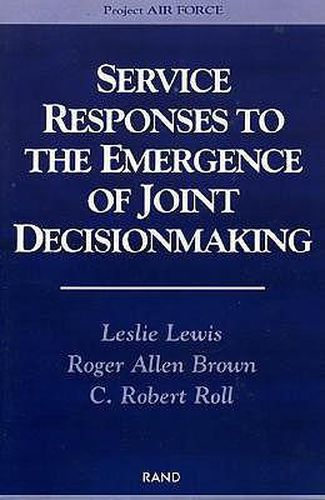Readings Newsletter
Become a Readings Member to make your shopping experience even easier.
Sign in or sign up for free!
You’re not far away from qualifying for FREE standard shipping within Australia
You’ve qualified for FREE standard shipping within Australia
The cart is loading…






An assessment of the manner in which the services have altered their planning, programming, and budgeting processes in response to the changes brought about by the 1986 Goldwater-Nichols legislation. The Goldwater-Nichols legislation, passed in 1986, sought to counterbalance the decisionmaking authority of the services by giving the Commanders-in-Chief (CINCs) a far greater voice in the determination of operational requirements. Toward this goal, the CINCs’ spokesperson, the Chairman of the Joint Chiefs of Staff, was empowered to integrate CINC requirements as well as to demonstrate how those requirements related to joint operational readiness. This report examines in detail how the Goldwater-Nichols legislation has affected decisionmaking within the Department of Defense and, more specifically, how the individual services have responded to the changes brought about by that legislation. After first describing the forces that underlay the passage of Goldwater-Nichols, the report outlines the manner in which the Departments of the Army, Navy, and Air Force have changed their decision models as well as their planning, programming, and budgeting processes in order to better respond to CINC demands. The report concludes that all of the services have to varying degrees undergone some reorganization in response to the changes brought about by Goldwater-Nichols. However, those changes, which have largely reflected the cultures of the individual services, have been incremental at best and have yet to fully meet the challenge this new decisionmaking environment has posed. [AF]
$9.00 standard shipping within Australia
FREE standard shipping within Australia for orders over $100.00
Express & International shipping calculated at checkout
An assessment of the manner in which the services have altered their planning, programming, and budgeting processes in response to the changes brought about by the 1986 Goldwater-Nichols legislation. The Goldwater-Nichols legislation, passed in 1986, sought to counterbalance the decisionmaking authority of the services by giving the Commanders-in-Chief (CINCs) a far greater voice in the determination of operational requirements. Toward this goal, the CINCs’ spokesperson, the Chairman of the Joint Chiefs of Staff, was empowered to integrate CINC requirements as well as to demonstrate how those requirements related to joint operational readiness. This report examines in detail how the Goldwater-Nichols legislation has affected decisionmaking within the Department of Defense and, more specifically, how the individual services have responded to the changes brought about by that legislation. After first describing the forces that underlay the passage of Goldwater-Nichols, the report outlines the manner in which the Departments of the Army, Navy, and Air Force have changed their decision models as well as their planning, programming, and budgeting processes in order to better respond to CINC demands. The report concludes that all of the services have to varying degrees undergone some reorganization in response to the changes brought about by Goldwater-Nichols. However, those changes, which have largely reflected the cultures of the individual services, have been incremental at best and have yet to fully meet the challenge this new decisionmaking environment has posed. [AF]